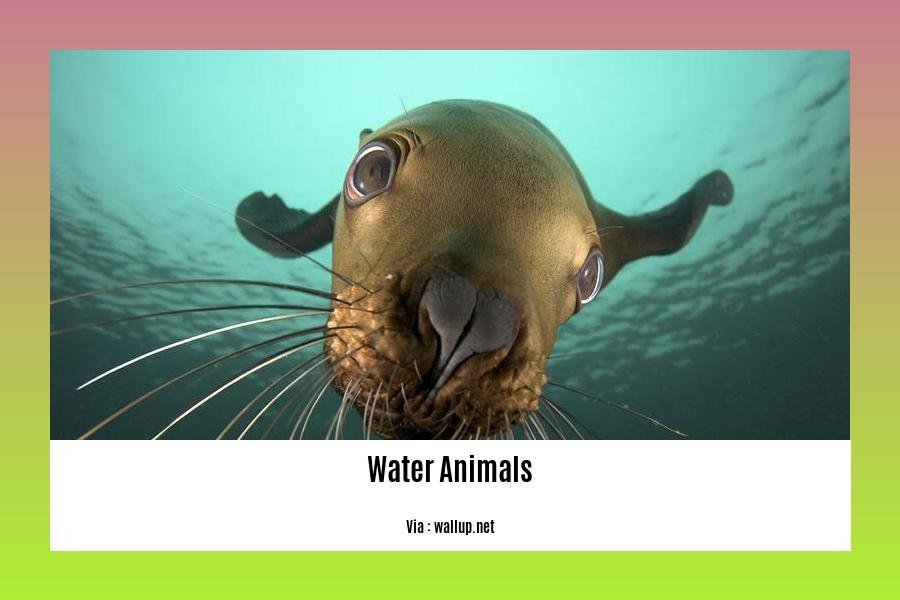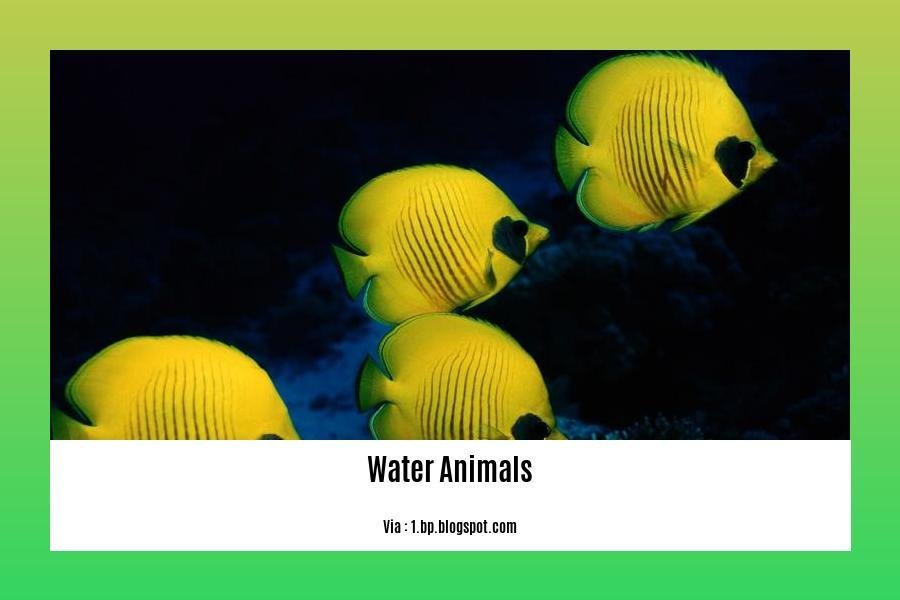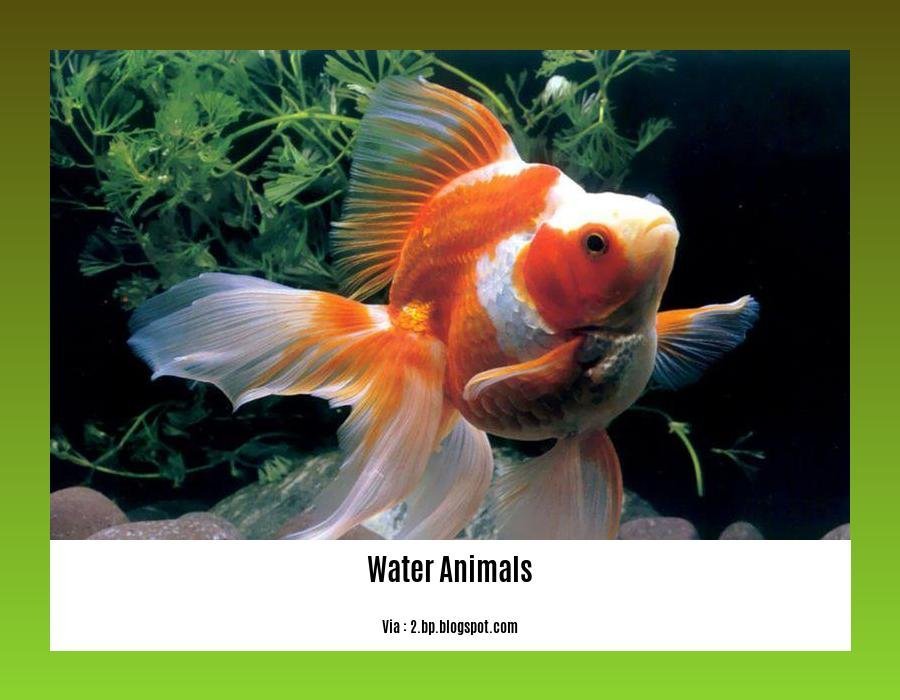Discover the hidden wonders lurking beneath the ocean’s surface as we embark on a journey to explore the enigmatic world of marine life. In this captivating article, we will delve into the fascinating facts about water animals, shedding light on their unique behavior and adaptations. Prepare to be amazed by the remarkable diversity and intricacies of these aquatic creatures as we unveil lesser-known facts, demystifying their wonders and igniting a sense of awe for the stunning world beneath the waves.
Key Takeaways:
- Jellyfish have existed for over 650 million years, making them older than dinosaurs and sharks.
- Electric Eels can generate enough electricity to power up to 10 electric bulbs.
- Dolphins sleep with only half of their brain and keep one eye open to stay alert for potential threats.
- The blue whale is responsible for producing the loudest sound on Earth, reaching up to 188 decibels.
- Octopuses possess three hearts, making them the only water animals with multiple hearts.
- Turtles can be found in all continents except Antarctica.
- Shrimps have their heart located in their head.
- Walruses can sleep in water and spend about 19-20 hours sleeping each day.
- Giant anteaters have the ability to consume over 30,000 insects in a single day.
- Starfish lack both a brain and blood, and they are not classified as fish.
Facts About Water Animals: Exploring the Enigmatic World of Marine Life

When it comes to water animals, their fascinating facts can leave us in awe of the incredible diversity and uniqueness found in the aquatic realm. From ancient creatures that have roamed the oceans for millions of years to extraordinary adaptations that help them survive in their habitats, the world of water animals is truly captivating. In this article, we will dive deeper into some intriguing facts about water animals that will leave you amazed at the wonders of marine life.
Jellyfish: Ancient and Mysterious
Let’s start our exploration with jellyfish, the ancient inhabitants of the oceans. Did you know that jellyfish have been around for more than 650 million years, pre-dating even dinosaurs and sharks? That’s right! These fascinating creatures have witnessed the rise and fall of many ancient species.
Electric Eel: Nature’s Living Battery
Now, let’s talk about electric eels, which possess an electrifying talent. These impressive creatures can produce enough electricity to light up to 10 electric bulbs! Imagine the power coursing through their bodies, enabling them to navigate and communicate in their watery world.
Dolphins: The Masters of Sleep
When it comes to sleeping underwater, dolphins have their own unique habits. Did you know that dolphins sleep with only half of their brain? This allows them to remain vigilant and alert, safeguarding themselves from predators and threats. With one eye open, dolphins can keep a watchful eye on their surroundings even while catching some necessary shut-eye.
Blue Whale: The Loudest Voice of the Ocean
In the vast expanses of the ocean, the blue whale reigns supreme. Not only is it the largest animal on Earth, but it also produces the loudest sound in the animal kingdom. The deep, low-frequency songs of blue whales can reach an incredible 188 decibels. To put that into perspective, a jet engine registers at around 140 decibels. The sheer power and magnitude of their vocalizations are truly awe-inspiring.
Octopus: The Master of Hearts
Moving on to the intriguing world of cephalopods, the octopus takes center stage. Did you know that octopuses are the only water animals with three hearts? Each heart serves a specific purpose—a systemic heart pumps oxygenated blood to the body, while two branchial hearts circulate blood through the gills. This remarkable adaptation allows octopuses to maintain their active and intelligent lifestyle in the depths of the sea.
Turtles: Global Travelers
Turtles, known for their slow and steady pace on land, lead a truly global existence. These resilient creatures can be found on every continent except Antarctica. With their ability to adapt to various environments, turtles have managed to colonize diverse habitats across the globe, from tropical beaches to frigid waters.
Shrimps: A Heart in the Head
You may be surprised to learn that shrimps don’t follow the usual heart placement found in most animals. In fact, shrimps have their heart situated in their head! This unique adaptation allows them to efficiently circulate blood and oxygen throughout their bodies, enhancing their ability to thrive in their marine habitats.
Walruses: Champion Sleepers
If there’s one creature that knows how to get a good night’s sleep, it’s the walrus. These marine mammals can snooze for an impressive 19-20 hours a day! What’s even more astonishing is that walruses can sleep in water, balancing their massive bodies effortlessly while enjoying a restful slumber in their aquatic domain.
Giant Anteaters: Insect Connoisseurs
Let’s shift our attention to the vibrant world of freshwater creatures for a moment. Giant anteaters are well-known for their insatiable appetite for insects. In fact, they can devour over 30,000 insects in a single day! These remarkable hunters play a vital role in controlling insect populations, maintaining the delicate balance of their ecosystems.
Starfish: Brains and Blood Not Required
Lastly, we have the enigmatic starfish. Contrary to their name, starfish are not actually fish, and they possess some intriguing characteristics. These captivating creatures have no brain or blood, yet they exhibit remarkable regenerative abilities. They can regenerate lost limbs, with some species even growing into whole starfish from just a single detached limb. Their resilience and ability to adapt to adversity make them true marvels of the sea.
In conclusion, the world of water animals is a treasure trove of wonders, filled with fascinating facts that continue to amaze and inspire us. From the ancient lineage of jellyfish and the electrifying abilities of electric eels to the intelligent hearts of octopuses and the peaceful slumber of walruses, these water animals showcase the incredible diversity and adaptability found within our oceans. By uncovering the mysteries and sharing these enticing facts about water animals, we hope to nurture a deeper appreciation and understanding of the remarkable creatures that call the aquatic realm their home. So, the next time you gaze out onto the ocean’s horizon, remember the extraordinary world that lies beneath the waves, waiting to be explored.
Therapy dogs provide remarkable benefits to individuals, contributing to their emotional well-being and overall happiness. If you’re curious to learn fascinating facts about therapy dogs, click here to uncover a world of heartwarming stories and surprising insights.
Veterinary technicians are the unsung heroes of animal healthcare, working alongside veterinarians to ensure the well-being of our furry friends. Discover captivating facts about veterinary technicians and their indispensable role by clicking here.
Working dogs are more than just loyal companions; they perform essential tasks that help save lives and improve our communities. Uncover intriguing facts about the incredible abilities and valuable contributions of working dogs by clicking here.
Strategies Water Animals Use for Survival and Reproduction

Water animals, with their unique adaptations and behaviors, have evolved various strategies for survival and reproduction. From internal and external fertilization to female choosiness in mating, these strategies play a crucial role in ensuring the continuation of their genetic lineage. Let’s delve into the fascinating world of water animal reproductive strategies.
Internal Fertilization: Ensuring Offspring Protection and Parental Care
Internal fertilization is a reproductive strategy predominantly observed in terrestrial animals, but certain aquatic mammals also utilize this method. In this strategy, the sperm is deposited directly into the female reproductive tract, where it fertilizes the egg. Internal fertilization offers several advantages. Firstly, it protects the developing embryos from desiccation, which is particularly crucial for land-dwelling species. Additionally, it enables parents to provide care and protection to the offspring, leading to increased survival rates. However, internal fertilization also poses challenges such as the need for physical contact and successful mating behaviors (Yoshida, 2020).
External Fertilization: Maximizing Offspring Production and Survival Chances
External fertilization is a common reproductive strategy observed in aquatic environments. In this strategy, both eggs and sperm are released into the water simultaneously, often through a process called spawning. External fertilization protects the eggs from drying out during development and facilitates the production of a large number of offspring. This increased quantity of offspring enhances the chance of survival in unpredictable and harsh aquatic environments. However, external fertilization presents challenges as it exposes the eggs and sperm to predation, environmental fluctuations, and dilution effects (OpenStax Biology).
Female Choosiness: Selective Mating and Differential Investment
In sexual reproduction, females tend to be more selective in choosing their mates compared to males, and various factors contribute to this phenomenon. One main factor is the differential investment in gametes and parental care. Females typically produce larger, energetically costly eggs and have a limited number of offspring they can produce throughout their lifetime. Therefore, they are under selective pressure to choose mates that possess qualities indicative of high genetic fitness and the ability to provide resources and support for the offspring. On the other hand, males, who produce numerous small, energetically inexpensive sperm, have a higher potential for reproductive success by mating with multiple partners.
This selective behavior is a result of sexual selection, a form of natural selection that occurs through interactions between males and females. Sexual selection leads to the evolution of traits associated with attractiveness, competitive ability, or parental care. It plays a crucial role in shaping reproductive strategies and behaviors in water animals (OpenStax Biology).
Key Takeaways:
– Internal fertilization occurs in terrestrial animals and provides protection and parental care to offspring.
– External fertilization is common in aquatic environments and allows for the production of a large number of offspring.
– Female choosiness in mating is influenced by the differential investment in gametes and parental care.
– Sexual selection drives the evolution of traits and behaviors related to successful reproduction.
Citations:
1. Yoshida, M. (2020). Chapter 1 Overview: Reproductive Systems in Aquatic Animals. Springer. Link
2. OpenStax Biology. (n.d.). Animal Reproductive Strategies. Georgia Institute of Technology. Link
Impacts of Environmental Factors on Water Animal Populations
Key Takeaways:
– Water pollution can have significant effects on water animal populations, including ecosystem alteration, death of animals, changes in behavior and physiology, restricted movement, alterations in metabolism, suffocation, and reproductive issues.
– Nutrient pollution can lead to algae growth, causing a reduction in oxygen supply to fish and other aquatic animals.
– Water pollution can disrupt the food chain, affecting the entire aquatic ecosystem.
– Long-term impacts of water pollution can result in species extinction.
Water animals are not immune to the impacts of environmental factors, particularly water pollution. The presence of pollutants in aquatic ecosystems can have detrimental effects on marine life, leading to significant consequences for these enigmatic creatures and their populations.
Ecosystem Alteration and Death of Animals
One of the most noticeable impacts of water pollution on water animal populations is ecosystem alteration. The introduction of pollutants into the water can disrupt the delicate balance of aquatic ecosystems, affecting the availability of resources and the overall health of the environment. These disruptions can lead to the death of animals, as their habitats become unsuitable for their survival.
Changes in Behavior and Physiology
Water pollution can also result in notable changes in the behavior and physiology of water animals. Toxic substances present in the water can influence their neurological and physiological processes, altering their normal functions. This can have cascading effects throughout the entire ecosystem, as changes in behavior and physiology can disrupt the intricate interactions between different species.
Restricted Movement and Altered Metabolism
The presence of pollutants in water bodies can restrict the movement of water animals, making it difficult for them to migrate or find food. These restrictions can have adverse effects on their survival and reproductive success. Additionally, water pollution can alter the metabolism of aquatic creatures, affecting their ability to process nutrients and energy efficiently.
Suffocation and Reproductive Issues
Water pollution can lead to the suffocation of water animals. Pollutants can reduce the oxygen content in the water, making it challenging for aquatic creatures to breathe. This can result in respiratory distress and even death. Furthermore, water pollution can interfere with the reproduction of organisms, affecting their ability to reproduce successfully and maintain healthy populations.
Disruption of the Food Chain
The impact of water pollution on the food chain is another significant concern. Pollutants can accumulate in the tissues of water animals, leading to bioaccumulation and biomagnification. This means that as smaller organisms consume contaminated food, the concentration of pollutants increases as it moves up the food chain. This disrupts the balance of the ecosystem, affecting the survival of various species and potentially leading to population declines.
Long-Term Impacts and Species Extinction
Water pollution can have long-term impacts on water animal populations. The cumulative effects of pollution over time can result in decreased population sizes and even the extinction of certain species. The loss of these species can have far-reaching consequences on the overall health and functioning of aquatic ecosystems.
By understanding the impacts of environmental factors, such as water pollution, on water animal populations, we can work towards implementing conservation strategies to protect these remarkable creatures. Through education and environmental awareness, we can strive to minimize water pollution and ensure the continued survival of our aquatic counterparts.
Sources:
1. Effects of Water Pollution on Animals – Environment Go! Retrieved from here
2. How Does Water Pollution Affect Animals? – WWF7 Water Resources. Retrieved from here
Lesser-known Facts About Specific Water Animal Species
Water animals encompass a diverse range of fascinating species, each with its own unique characteristics and adaptations. Below, we uncover some lesser-known facts about specific water animal species, shedding light on the wonders of marine life.
Seahorses: Males that Give Birth
Let’s start with seahorses, which possess a truly remarkable reproductive strategy. Unlike most animal species, seahorses are the only ones in which the males give birth and care for their young. The male seahorse carries the developing eggs in a specialized pouch until they hatch, providing parental care rarely seen in the animal kingdom.
Sea Sponges: Living without Body Parts
Sea sponges may seem mysterious, as they lack traditional body parts such as a head, mouth, eyes, feelers, bones, heart, lungs, or brain. Yet, they are indeed alive. These incredible creatures manage to survive and thrive with their unique cellular structure and the ability to filter nutrients from the water.
Oysters: Gender Change for Mating
Oysters have another surprising trait: they are capable of changing their gender. Depending on mate availability and environmental conditions, oysters can switch between being male and female. This ability allows them to maximize their chances of successful reproduction.
Dolphins: Intelligent and Self-Recognizing
Dolphins, found all around the world, are renowned for their intelligence and social behavior. But did you know that dolphins can recognize themselves in a mirror? This self-recognition ability highlights their advanced cognitive abilities, placing them in an elite group of animals capable of such self-awareness.
Turtles: Ubiquitous Travelers
While most people associate turtles with the sea, these remarkable reptiles can be found on every continent except Antarctica. From ocean-dwelling species to those inhabiting freshwater environments, turtles have managed to adapt and thrive in a variety of habitats across the globe.
Marine Mammals: The Masters of Sound
Many marine mammals, such as whales and dolphins, possess an amazing talent: the ability to produce high-pitched sounds. These sounds, known as echolocation, help them navigate, communicate, and locate prey in the vast depths of the ocean. Their expertise in sound production and reception is truly remarkable.
Key Takeaways:
- Seahorses defy traditional reproductive norms, with males giving birth and caring for their young.
- Sea sponges, despite lacking body parts, are alive and thrive through unique cellular structures.
- Oysters have the ability to change their gender, adapting for optimal mating conditions.
- Dolphins exhibit advanced intelligence, capable of recognizing themselves in a mirror.
- Turtles can be found on every continent except Antarctica, showcasing their impressive adaptability.
- Marine mammals, like whales and dolphins, possess exceptional sound-producing capabilities for communication and navigation.
Source 1: All That’s Interesting – Ocean Animals Facts
Source 2: You For Animal – Discovering the Aquatic World
FAQ
Q1: What are some interesting facts about water animals?
A1: Some interesting facts about water animals include the fact that jellyfish have been around for more than 650 million years, dolphins sleep with only half of their brain and with one eye open to watch for predators, and starfish have no brain or blood.
Q2: Do aquatic animals have different reproductive strategies?
A2: Yes, aquatic animals exhibit different reproductive strategies. Some species utilize internal fertilization, where sperm is deposited directly into the female reproductive tract, while others employ external fertilization, where eggs and sperm are released into the water simultaneously.
Q3: How does water pollution affect animals in aquatic ecosystems?
A3: Water pollution can have significant effects on aquatic animals. It can lead to ecosystem alteration, changes in behavior and physiology, suffocation, and even death of animals. It can also impact the reproduction of organisms and have long-term effects on animal populations, including the risk of species extinction.
Q4: What are some unique characteristics of water animals?
A4: Some unique characteristics of water animals include the blue whale producing the loudest sound on Earth, octopuses having three hearts, and shrimps having their heart situated in their head. Seahorses are also the only animals in which the males give birth and care for their young.
Q5: Why are females often more selective in their mating choices than males?
A5: Females are often more selective in their mating choices due to factors such as differential investment in gametes and the effects of sexual selection. Females typically produce larger, energetically costly eggs and have a limited number of offspring they can produce throughout their lifetime. They are, therefore, under selective pressure to choose mates that possess qualities indicative of high genetic fitness and the ability to provide resources and support for the offspring.










